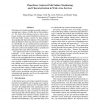Free Online Productivity Tools
i2Speak
i2Symbol
i2OCR
iTex2Img
iWeb2Print
iWeb2Shot
i2Type
iPdf2Split
iPdf2Merge
i2Bopomofo
i2Arabic
i2Style
i2Image
i2PDF
iLatex2Rtf
Sci2ools
OSDI
2004
ACM
2004
ACM
PlanetSeer: Internet Path Failure Monitoring and Characterization in Wide-Area Services
Detecting network path anomalies generally requires examining large volumes of traffic data to find misbehavior. We observe that wide-area services, such as peerto-peer systems and content distribution networks, exhibit large traffic volumes, spread over large numbers of geographically-dispersed endpoints. This makes them ideal candidates for observing wide-area network behavior. Specifically, we can combine passive monitoring of wide-area traffic to detect anomalous network behavior, with active probes from multiple nodes to quantify and characterize the scope of these anomalies. This approach provides several advantages over other techniques: (1) we obtain more complete and finergrained views of failures since the wide-area nodes already provide geographically diverse vantage points; (2) we incur limited additional measurement cost since most active probing is initiated when passive monitoring detects oddities; and (3) we detect failures at a much higher rate than other researchers ...
Large Traffic Volumes | Operating System | OSDI 2004 | Wide-area Network Behavior | Wide-area Traffic |
| Added | 03 Dec 2009 |
| Updated | 03 Dec 2009 |
| Type | Conference |
| Year | 2004 |
| Where | OSDI |
| Authors | Ming Zhang, Chi Zhang, Vivek S. Pai, Larry L. Peterson, Randolph Y. Wang |
Comments (0)

